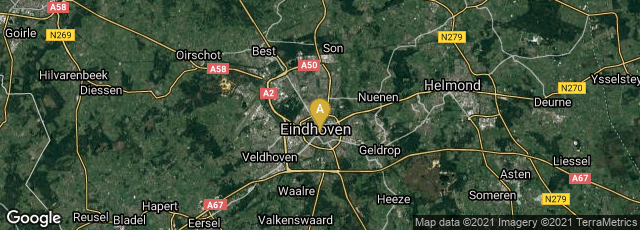

A: Centrum, Eindhoven, Noord-Brabant, Netherlands
In 1976 Phillips and Sony developed the compact disc (CD), an optical disc used to store and playback digital data. It was originally developed to store and playback sound recordings exclusively. CDs can hold up to 700 megabytes. This equates to up to 80 minutes of uncompressed audio. By 2007 200 billion CDs were sold worldwide.
"Philips publicly demonstrated a prototype of an optical digital audio disc at a press conference called "Philips Introduce Compact Disc" in Eindhoven, The Netherlands on March 8, 1979. Three years earlier, Sony first publicly demonstrated an optical digital audio disc in September 1976. In September 1978, they demonstrated an optical digital audio disc with a 150 minute playing time, and with specifications of 44,056 Hz sampling rate, 16-bit linear resolution, cross-interleaved error correction code, that were similar to those of the Compact Disc introduced in 1982. Technical details of Sony's digital audio disc were presented during the 62nd AES Convention, held on March 13-16, 1979 in Brussels.
"The first test CD was pressed in Hannover, Germany by the Polydor Pressing Operations plant in 1981. The disc contained a recording of Richard Strauss's Eine Alpensinfonie, played by the Berlin Philharmonic and conducted by Herbert von Karajan. The first public demonstration was on the BBC TV show Tomorrow's World when The Bee Gees' 1981 album Living Eyes was played. In August 1982 the real pressing was ready to begin in the new factory, not far from the place where Emil Berliner had produced his first gramophone record 93 years earlier. By now, Deutsche Grammophon, Berliner's company and the publisher of the Strauss recording, had become a part of PolyGram. The first CD to be manufactured at the new factory was The Visitors by ABBA. The first album to be released on CD was Billy Joel's 52nd Street, that reached the market alongside Sony's CD player CDP-101 on October 1, 1982 in Japan. Early the following year on March 2, 1983 CD players and discs (16 titles from CBS Records) were released in the United States and other markets. This event is often seen as the "Big Bang" of the digital audio revolution. The new audio disc was enthusiastically received, especially in the early-adopting classical music and audiophile communities and its handling quality received particular praise. As the price of players sank rapidly, the CD began to gain popularity in the larger popular and rock music markets. The first artist to sell a million copies on CD was Dire Straits, with its 1985 album Brothers in Arms. The first major artist to have his entire catalogue converted to CD was David Bowie, whose 15 studio albums were made available by RCA Records in February 1985, along with four Greatest Hits albums. In 1988, 400 million CDs were manufactured by 50 pressing plants around the world. To date, the biggest selling CD (as opposed to the biggest selling title) is Beatles "1", released in November 2000, with worldwide sales of 30 million discs" (Wikipedia article on Compact Disc, assessed 01-17-2010).